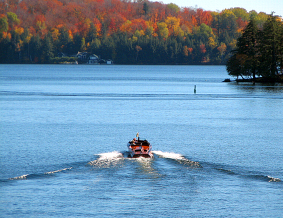Many boaters delay pulling their boats for the season to take advantage of that occasional perfect autumn day. Crisp, cool, calm air and bright sunshine make these days on the water very special. Some of the year’s best fishing occurs in the fall, and there’s no better way to enjoy the fall colors than from a boat. But the arrival of fall’s shorter days and cooler temperatures presents unique challenges to boaters. Here are a few tips on how to prepare:
1. It’s quiet out there. Make sure you can be heard. Compared to the busier times of the season, there may not be other boaters in your vicinity to turn to for assistance at this time of year. Many areas cut back their on-water law enforcement presence once the primary boating season is over, so water patrol boats may be fewer and farther between. That makes it all the more important than ever to make sure your VHF radio and cell phone are in good working order. You can use your VHF radio to call for help even in spots where your cell phone has no signal. If things do start to hit the fan, a VHF call on channel 16 is your direct link to the Coast Guard. You’ll be talking directly to the people who can launch a rescue, and other nearby boats may be listening and can lend a hand.
2. Bring along an extra layer of clothing. It may seem like a warm, summer-like day ashore, but in fall you want to dress for the cooler water temperature more than the air temperature. And have rain gear aboard, as fall can bring fast-moving storms that can cause the temperature to drop unexpectedly.
3. Wear your life jacket. In the fall, the water gets colder every day and an accidental fall overboard run can result in an increased risk of hypothermia. Children 12 and under must wear a life jacket any time your boat is underway by law, and it’s a good idea for adults to wear them, too – especially at night. Purchase life jackets with lights attached so rescuers can find you in the water. Make sure they fit over your bulky “fall layers” – jackets, sweatshirts, etc. Consider a flotation coat or a decksuit-style PFD designed to keep you afloat and insulated.
4. Check your boat’s systems before you head out. With shorter days and colder water, it becomes extra important to have your boat’s systems working properly. Darkness falls early this time of year, so make sure that your boat’s navigational lights are working properly, check that your emergency flares aren’t past the expiration date, and carry a few waterproof flashlights and extra batteries to help unload passengers and gear at the dock after dark.
5. Know how to use your electronics. The appearance of sudden fog and earlier sunsets can quickly change your perspective, even in familiar waters. It will pay to be comfortable with using your chart plotter and radar if visibility becomes a problem.
6. Gas up before you go. With fewer boats on the water, some fuel docks close early during the fall season. Don’t assume you can fill up at your destination for the trip home.
7. Keep an eye to the sky. Autumn storms can approach fast and unexpectedly, and they often pack more of a punch than summer showers. Not only should you check the weather before heading out, but be sure to check the weather during your trip and keep an eye out for approaching fronts. Conditions can change quickly.

Nice tips! I appreciate your advice to check your boat before you sail off as it is indeed crucial that the boat’s systems are working properly. I always wanted to buy a boat and finally, I have such a possibility, and I’ll make sure I keep it in proper condition to sail safely. Thanks!